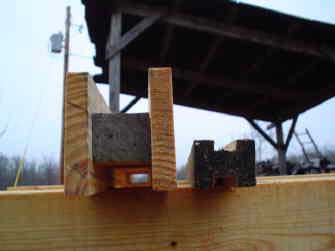Stickering and Drying Large Timbers
Large-dimension timbers for framing should be handled correctly to minimize bowing and checking. June 23, 2005
Question
I am looking to cut some timbers from Pennsylvania white pine and I’m not really sure how to go about drying them. They are going to be used for a timber frame project. I am wondering if I should leave them in log form and air-dry them for a while, or if I should cut them into cants approximately the size I need them? I’m not really sure how to proceed with them. Any help would be great.
Forum Responses
(Sawing and Drying Forum)
From contributor S:
I saw for several timber frame builders, and most timbers air-dry in less than 6 months and some not at all. The one thing to keep in mind if you are going to dry is to keep the timbers off of the ground abound 18 inches on study blocking - you don't want them to bow. Also, try to keep the direct sun and rain off of them, as they will check and turn gray.
From contributor E:
I am also planning a timber frame project. I was wondering, when the timber framers who do dry, do they dry as a log or as a timber? Also, if they dry as a timber, is it oversized so as to be re-cut to size after drying?
From contributor D:
To contributor E: Usually dry as timbers, not as logs.
From contributor T:
Also, pine dried logs are more likely to attract bugs and will blue stain as they dry. The stain will not hurt things structurally, but the logs will have a concentric ring that will turn blue due to fungus.
From contributor A:
When stickering timbers, it is best if they are on 2 x 2's and have space between them. If you want a fresh face, then over-saw then by 1 inch. Then you can re-saw them before installing and have a clean cut face. If you want it to check to a face plunge, cut it now and stack the cut down. In pine it is not as important to seal the ends as it is in hardwoods, which I do about 4 inches up.
From contributor J:
To contributor A: What do mean by face plunging and stacking the cut down?
From contributor A:
You put one of the 1/16 thick circle saw blades and set the depth of cut to about 1 to 1 1/2 deep. Then, you go about 6 inches from the end of the timber and plunge the blade in and cut down the middle of the face to about 6 inches of the other end. You do this on a face that is not going to be seen. Most of the checking will go to that face.
When you sticker the timber, put the saw cut down so water does not get in and cause problems. I put 2 x 2's about every 4 feet and cover it with tin with a good over-hang. If a good size timber wants to move, it will move no matter what you put on top - short of a D8 dozer. My 2 x 2's have a dado cut and look like a fat letter H to help with staining.
From contributor A:
I also put 4 x 6's under my piles, about ever 4 feet on top of 2 cinder blocks. I put a 1 x 1 sticker on top of that, and then put in the first row of timbers, keeping them about 1 inch apart. Rows after that get the 2 x 2 stickers that look like a fat H. After about 3 rows of timbers I put the big H's, which are 1 x 4's with a 2 x 2 nailed between them. This allows me to pick the pile up later, or stack them on the ground and put the stack up there. They keep stain down as well. I cover the piles with tin with a foot of overhang all around. Here’s a picture below.

